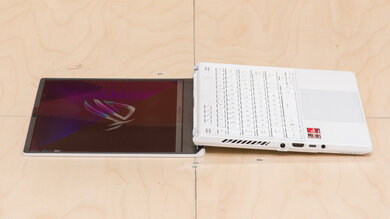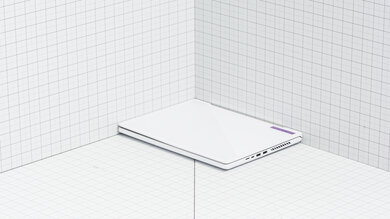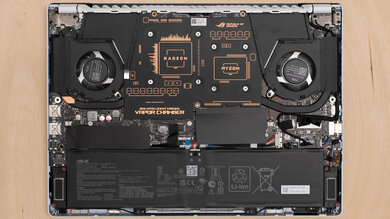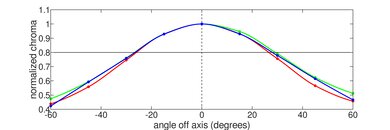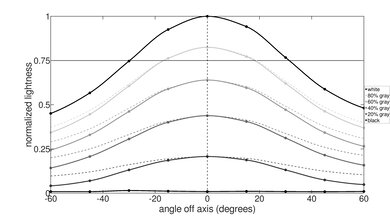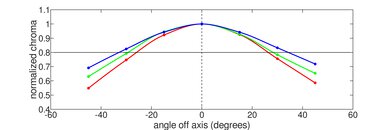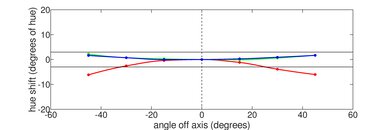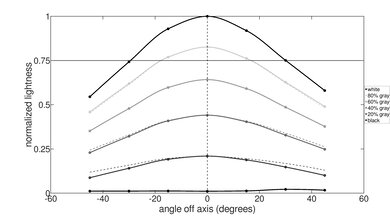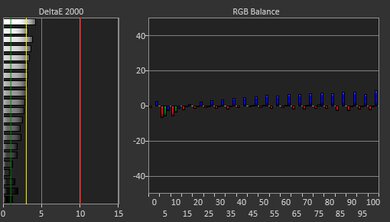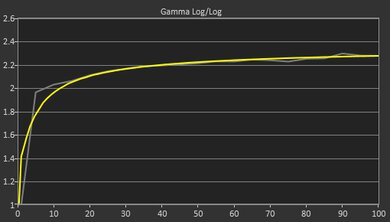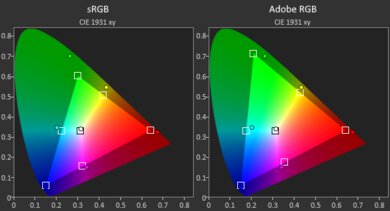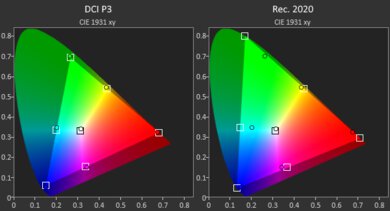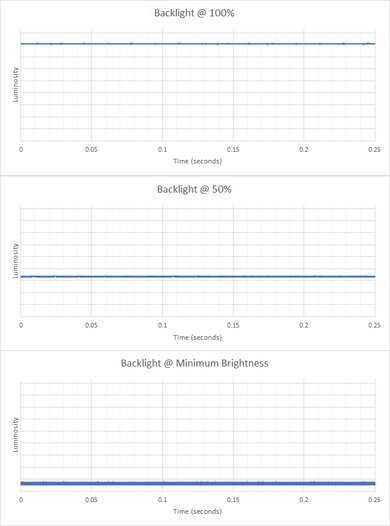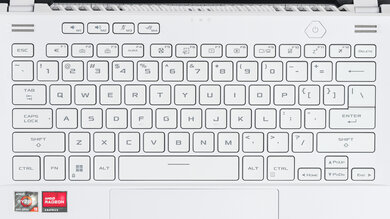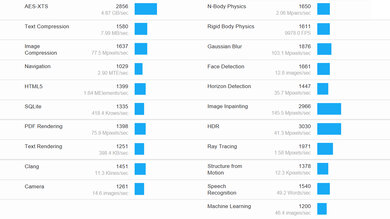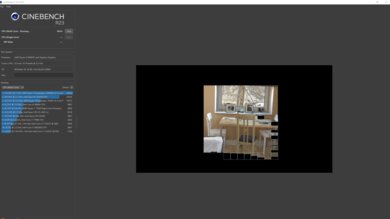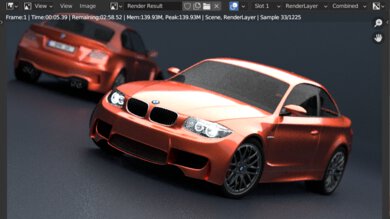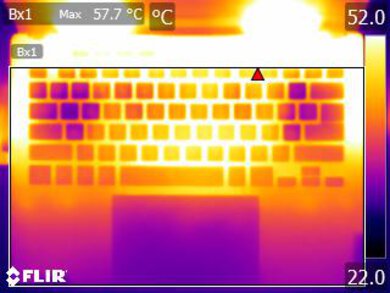The ASUS ROG Zephyrus G14 (2022) is a 14-inch gaming laptop. It's available with an AMD Ryzen 7 6800HS or Ryzen 9 6900HS CPU paired with an AMD Radeon 6700S or 6800S discrete GPU. Memory and storage max out at 32GB and 1TB, respectively. There are two display options: a 144Hz FHD+ or a 120Hz QHD+ panel; both support FreeSync variable refresh rate support to reduce screen tearing. It has a 720p webcam, Wi-Fi 6E wireless connectivity, and a 76Wh battery. Ports include two USB-As, two USB-Cs, an HDMI, a MicroSD card reader, and a 3.5 mm headphone jack. The USB-Cs support charging and video output, but not Thunderbolt 4 or USB4.
See our unit's specifications and the available configuration options in the Differences Between Variants section.
Our Verdict
The ASUS ROG Zephyrus G14 is good for school use. It's a compact laptop that's easy to carry around, and it has more than enough processing power to handle demanding workloads, which is great for students in fields like graphic design or 3D animation. The display is sharp and bright, the keyboard feels comfortable to type on for an extended period, and the touchpad is large and responsive. The battery lasts a little over 10 hours of light productivity, but you might still need to plug it in if you perform any CPU- or GPU-intensive tasks, and the power adapter is pretty bulky.
- Feels well-built.
- Battery lasts over 10 hours of light use.
- Thin and light design.
- CPU and GPU can handle demanding workloads.
- Comfortable keyboard and responsive touchpad.
- Gets hot and loud under load.
- Bulky power adapter.
The ASUS ROG Zephyrus G14 is great for gaming. You can get this laptop with a 144Hz FHD+ or 120Hz QHD+ display; both deliver a clear image in fast-moving scenes and support variable refresh rate to minimize screen tearing. Its AMD CPU and GPU provide a smooth gaming experience in 1080p and 1440p, though you'll have to turn the settings down a bit at 1440p to reach 60 fps in some games. Unfortunately, it gets hot and loud under load, and the GPU throttles slightly.
- CPU and GPU provide a smooth gaming experience at 1080p or 1440p.
- Comfortable keyboard and responsive touchpad.
- High-refresh displays with a fast response time and VRR support.
- Wide port selection.
- User-replaceable RAM and storage.
- Gets hot and loud under load.
- Some thermal throttling on GPU.
The ASUS ROG Zephyrus G14 is decent for media consumption. It's a thin, light laptop that's easy to carry around, and while its power adapter is bulky, you likely won't need it as the battery lasts about eight hours of video playback. The display is sharp, bright, and colorful, though it isn't the best option for dark room viewing as its low contrast makes blacks look gray in dim settings. Likewise, the speakers get reasonably loud but have no bass and sound muffled.
- Sharp, bright, and colorful display.
- Thin and light design.
- Battery lasts around eight hours of video playback.
- Blacks look gray in dim settings.
- No local dimming for HDR.
- Speakers sound muffled and lack bass.
The ASUS ROG Zephyrus G14 is excellent as a workstation. Its AMD CPU and GPU have enough processing power to handle demanding tasks like video editing and 3D animation, and it's available with a sharp QHD display that's suitable for content creation. The keyboard feels comfortable to type on for hours, and its wide port selection includes an HDMI port and two USB-Cs that can also output a video signal to an external monitor. Unfortunately, it gets hot and loud under load, and there's some thermal throttling on the GPU.
- CPU and GPU can handle demanding workloads.
- Comfortable keyboard and responsive touchpad.
- Display is suitable for content creation.
- Wide port selection.
- User-replaceable RAM and storage.
- Gets hot and loud under load.
- Some thermal throttling on GPU.
The ASUS ROG Zephyrus G14 is great for business use. It's a well-built, thin, and light laptop that's easy to carry around, and although its power adapter is bulky, you might not need it as the battery lasts over 10 hours of light productivity. The display is sharp and bright, the keyboard feels great to type on, and the touchpad is large and responsive. The webcam's video quality is good even though it's only 720p, and the microphone sounds loud and clear with only a bit of static in the background. Its AMD CPU is powerful enough to handle all types of workloads, like simple tasks like text formatting and video calls or more intensive large number-crunching in Excel.
- Feels well-built.
- Battery lasts over 10 hours of light use.
- Thin and light design.
- CPU and GPU can handle demanding workloads.
- Comfortable keyboard and responsive touchpad.
- Gets hot and loud under load.
- Bulky power adapter.
Changelog
- Updated Apr 29, 2024: We've updated the review to provide more information about additional display and CPU options. The laptop is available with a 144Hz FHD+ display and an AMD Ryzen 7 6800HS CPU.
- Updated Dec 07, 2023: Converted to Test Bench 0.8.2.
- Updated Nov 24, 2023: Added mention of the Dell Alienware m16 R1 (2023) as an alternative with less thermal throttling in the Performance Over Time section.
- Updated Nov 03, 2023: Converted to Test Bench 0.8.1.
Differences Between Sizes And Variants
We tested the ASUS ROG Zephyrus G14 2022 (model GA402R) with an AMD Ryzen 9 6900HS CPU, an AMD Radeon RX 6700S dedicated GPU, 16GB of memory, and 1TB of storage. The GPU, memory, and storage are configurable; you can see the available options in the table below. Our review applies only to the GA402RJ and GA402RK models.
| Screen |
|
| CPU |
|
| GPU |
|
| Memory |
|
| Storage |
|
| Color |
|
See our unit's label here.
Popular Laptop Comparisons
The ASUS ROG Zephyrus G14 is among the best gaming laptops in its size and class. It stands out for its thin and light design, high-quality display, great performance, and long battery life. However, it isn't as serviceable as other gaming laptops since half of the memory is soldered on, and its USB-C ports don't support USB4 standards for faster transfer speeds when gaming off an external drive.
For more options, check out our recommendations for the best gaming laptops, the best laptops, and the best laptops for college.
The ASUS ROG Zephyrus G14 (2024) is a newer version of the ASUS ROG Zephyrus G14 (2022), albeit two generations apart. Although both models are available with AMD CPUs, the 2022 version is only configurable with AMD GPUs, while the newer 2024 is only configurable with NVIDIA 40-series GPUs. If your primary concern is performance, the 2024 model is a better choice, as it can push higher frame rates and provide more processing for demanding productivity tasks. The 2024 model also has a more compact, less gamer-oriented design, making it more suitable for work in a professional environment. Unfortunately, RAM support hasn't changed, as you can only get up to 32GB of memory, which might not be enough for highly complex workloads.
The Razer Blade 14 (2022) and the ASUS ROG Zephyrus G14 (2022) are both thin and light 14-inch high-end gaming laptops. The Razer is a more premium-feeling device overall, and it delivers a smoother gaming experience with a faster 165Hz display and better-performing GPUs. However, the ASUS might be a better choice for productivity tasks as it has a longer battery life and a brighter display to combat glare in well-lit settings. You can also configure the ASUS with more memory, which is important for demanding workloads with large datasets.
Although the ASUS ROG Zephyrus G14 (2022) and the Apple MacBook Pro 14 (M1, 2021) are very different devices, there's some overlap as the G14 has the processing power to be an excellent Windows workstation alternative to the MacBook Pro 14. The MacBook Pro 14 is a more premium device that offers a better user experience, as it has better-sounding speakers, a Mini LED display that produces deeper blacks, and a much better webcam. The MacBook Pro 14 also has a longer battery life and doesn't get as hot or loud under load. For gaming, though, it's best to go with the G14 because there aren't many games optimized for macOS running on Apple silicon, and the MacBook Pro 14's display has a slow response time.
The Lenovo Legion Pro 5 Gen 8 16 (2023) is slightly better than the ASUS ROG Zephyrus G14 (2022). The Lenovo is available with faster AMD 7000 CPUs and NVIDIA RTX 40-series GPUs, so it can achieve higher frame rates and handle more demanding games. It also has a faster SSD, which helps shorten loading times in games, and unlike the ASUS, both of its RAM modules are user-replaceable. The Lenovo has higher refresh display options, a better 1080p webcam, a wider port selection, and lower fan noise. On the other hand, the ASUS is more portable, and its battery lasts much longer when performing light tasks.
Test Results

The ASUS ROG Zephyrus G14 looks fairly stylish. It has some gamer aesthetics, like the shape of the power button and speaker grills, but it doesn't go overboard with it, so you can still use it in a professional working environment without sticking out too much. It has a perforated lid that allows LED lights to shine through, which you can customize to show anything you want. The AniME Matrix feature is optional; you can get the laptop without it. There are vents on both sides of the laptop and on the back and bottom. The screen lifts the back of the laptop when opened, giving you a slight keyboard incline and allowing for better airflow on the bottom. It's available in two colors: Moonlight White and Eclipse Gray.
The build quality is great. Although it feels more like plastic, ASUS specifies that the chassis is a mix of aluminum and magnesium alloy. The laptop feels high-quality and sturdy, exhibiting only a little bit of flex in the display and almost none in the keyboard deck. The finish feels smooth and doesn't pick up fingerprints or scratch easily.
The ASUS ROG G14 has outstanding hinges. They feel smooth when opening and closing the laptop, and they're very stable, with almost no wobbling whatsoever. You can open the lid with one hand, which isn't the most necessary feature, but it does give the laptop a more premium feel.
The serviceability is good. Accessing the internals is very easy as you only need to remove some Philips screws and undo the clips holding the bottom panel. You don't need a pick to pry open the panel, but you need one to remove the rubber covering three of the screws. The laptop has half of its memory in the form of a SO-DIMM module, with the other half soldered onto the motherboard, so you can only upgrade to a maximum of 24GB on a 16GB model. You can see the upgrade guide here. If you want a gaming laptop with better serviceability, check out the MSI Raider GE67 HX (2022).
The ASUS Zephyrus G14 is available with the following displays:
- 14" IPS 1920 x 1200 144Hz (100% sRGB)
- 14" IPS 2560 x 1600 120Hz (100% DCI P3, Dolby Vision)
Both displays look very sharp. The QHD+ panel is technically sharper, though the difference is hard to notice at typical viewing distances, especially on a 14-inch display. Both have a 16:10 aspect ratio, which is great for productivity, as you get slightly more vertical space than a standard 16:9 screen, allowing you to see more information when reading a document or website. If you want a gaming laptop with a larger screen, check out the HP OMEN 16 (2022).
The ASUS ROG Zephyrus G14's panel has a high refresh rate and a quick response time, resulting in better responsiveness and a clearer image in fast-moving scenes. There's some image duplication, but it isn't too bad. The FHD+ display has a 144Hz refresh rate, so it'll feel a tad more responsive, though it has the same advertised response time of 3 ms. If you want a gaming laptop with a higher refresh display, check out the Razer Blade 14 (2022).
The ASUS G14 gets bright enough to combat glare, even in very well-lit settings or outdoors in broad daylight. It also gets very dim to help reduce eye strain when viewing content in the dark. There's an auto-brightness feature called Vari-Bright, which automatically adjusts the screen brightness to extend battery life. It's on by default, but it only takes effect when running on battery and doesn't impact the screen brightness when plugged in. The FHD+ display has the same advertised brightness.
The ASUS ROG Zephyrus G14's reflection handling is decent. Reflections aren't a problem when viewing light-color content because the display gets bright enough to compensate, but they're visible and distracting when viewing dark content, especially direct reflections, like a lamp or open window during the day.
The display's horizontal viewing angle is okay. The image dims and washes out fairly quickly as you move off-center, which isn't an issue when sharing a text document or casual content, but it isn't ideal for sharing color-critical work. If you need perfect accuracy, it's best to be close to or directly in front of the screen.
The display's vertical viewing angle is passable. The image dims and washes out fairly quickly from above or below, so you'll have to look at the screen almost directly if accuracy is important, which might be hard when you don't have much space to tilt the screen, like on a bus or airplane.
The QHD+ display's out-of-the-box accuracy is good. Most colors look oversaturated because the laptop targets a wide gamut, even in sRGB content, and the white balance is also off, especially at higher brightness levels. The color temperature is a bit cooler than the standard 6500k target, giving the image a slight, almost imperceptible, blueish tint. The gamma follows the sRGB curve almost perfectly; there's only some over-darkening in dark scenes. Note that these results are obtained with Vari-Bright disabled, a feature that automatically adjusts the screen brightness to extend battery life. This feature is on by default and only comes into effect when the laptop runs on battery; however, it seems to affect color accuracy, even when plugged in. With Vari-Bright enabled, the color and white balance dEs are slightly worse, the color temperature is warmer at 6305 K, and the gamma sticks almost to a flat 2.2.
Since the default color profile is in the DCI P3 color space, we've also measured the display as a P3 display. Here are the results:
The QHD+ display has an outstanding color gamut. It has full coverage of the sRGB and DCI P3 color spaces, making it suitable for viewing or producing SDR and HDR content. For print photography, its Adobe RGB coverage is excellent but still missing the saturated greens that define Adobe RGB. The FHD+ display only has full sRGB coverage.
The ASUS ROG Zephyrus G14 has a great keyboard. The layout feels spacious and is fairly standard, so it doesn't take long to get used to. The keys have a lot of travel, don't require much force to actuate, and provide satisfying tactile feedback. The overall typing experience is great, and it doesn't feel tiring over an extended period. You can customize the RGB backlight through the ASUS Aura Creator application. There's only one lighting zone, though, so you can only change the color and the lighting effect. You can adjust between three brightness levels or turn off the backlight directly on the keyboard using Fn + F2 or F3.
The ASUS G14 has an excellent touchpad. It's large, even though it's a relatively compact laptop, and it feels smooth, allowing the fingers to glide easily. It tracks all movements and gestures well, and there aren't any issues with palm rejection or actions like dragging and dropping. The click mechanism feels satisfying, but you can only click on the bottom half of the touchpad.
The ASUS G14's speakers are just okay. It has a quad-speaker system with two up-firing and two down-firing drivers. They have good instrument separation and relatively clear vocals; however, they have almost no bass whatsoever, and they sound muffled and slightly unnatural. They get reasonably loud with very little dynamic compression, but they cause the keyboard deck to vibrate a lot at higher volume levels, which might bother some people. There's Dolby Atmos support, meaning the system can decode Dolby Atmos content in supported apps.
The ASUS G14's webcam video quality is good. The image looks a bit soft and noisy, but the exposure is good, and the colors look true to life. The microphone sounds loud and clear; however, voices come across as slightly hollow and nasal-sounding with noise cancelling on, and there's a small amount of static in the background.
The ASUS ROG Zephyrus G14 has a great port selection. The USB-A and USB-C ports support USB 3.2 Gen. 2 data transfer speed (up to 10Gbps). Both USB-C ports can output a video signal to an external display; however, they don't deliver the same performance because the left USB-C port connects to the AMD Ryzen 9 6900HS' integrated GPU, while the right one connects to the dedicated GPU, the same as the HDMI port. The left USB-C port supports Power Delivery, allowing you to fast-charge the laptop and other PD-supported mobile devices connected to the port. If you need a gaming laptop with HDMI 2.1 support, check out the ASUS ROG Flow X13 (2023).
The ASUS Zephyrus G14's wireless adapter is a MediaTek Wi-Fi 6E MT7922 160Hz. Wi-Fi 6E adds access to the 6GHz airwaves, providing greater speeds, lower latency, and less signal interference than previous Wi-Fi standards. However, you need a router that supports Wi-Fi 6E to benefit from these features.
The ASUS ROG Zephyrus G14 is available with the following CPUs:
- AMD Ryzen 7 6800HS (8 cores/16 threads, up to 4.7GHz, 16MB cache)
- AMD Ryzen 9 6900HS (8 cores/16 threads, up to 4.9GHz, 16MB cache)
Both are high-performance mobile CPUs designed for gaming laptops and mobile workstations with a relatively thin chassis, running at a default 35W TDP instead of the usual 45W of other H-series chips. Ryzen 6000 CPUs have better efficiency than the previous generation, leading to a longer battery life and a slight performance increase. They also sport a more powerful integrated GPU, resulting in a smoother overall experience in lighter workloads. The 6900HS is only slightly faster than the 6800HS. Both are behind the high-end Intel 12th Gen H-series processors in performance, especially at higher power levels; however, they're still powerful enough to handle demanding tasks like gaming, video editing, and 3D rendering.
You can configure the ASUS ROG Zephyrus G14 with the following AMD dedicated GPUs:
- AMD Radeon RX 6700S with 8GB of GDDR6 VRAM (100W TGP with SmartShift)
- AMD Radeon RX 6800S with 8GB of GDDR6 VRAM (105W TGP with SmartShift)
The AMD Radeon RX 6700S is a mid-range dedicated GPU with performance equivalent to an NVIDIA GeForce RTX 3060 or an RTX 3070, depending on the game or application. It can handle gaming at 1440p, but you'll have to lower some settings to get around or over 60 fps in graphically demanding games. You can also get higher frame rates by turning on FidelityFX Super Resolution (FSR), though only a limited number of games support it at this time. FSR is a feature that boosts performance by rendering the game at a lower resolution and upscaling the image afterward to minimize any loss in visual quality, similar to NVIDIA's DLSS. If you want to take full advantage of the display's 120Hz refresh rate, it's best to play at 1080p. The lower resolution is easier to drive and doesn't look significantly worse due to the size of the display. There's ray-tracing support, but it has a high performance cost, so it's only worth turning on if you also enable FSR to make up for the performance loss. The AMD Radeon RX 6800S is faster than the RX 6700S, giving you a 5% to 15% performance increase on average. Both GPUs are suitable for production workloads like video editing and 3D rendering. If you want a laptop with NVIDIA 40-series GPUs, check out the Dell Alienware m18 (2023).
The ASUS ROG Zephyrus G14 has a MUX (multiplexer) switch to allow the dedicated GPU to send information directly to the display without going through the integrated GPU, resulting in better performance than a laptop that lacks this feature. The laptop is in Hybrid Mode by default, allowing the system to switch between the integrated graphics and the dedicated GPU to extend battery life.
You can configure this laptop with 16GB or 32GB of memory. Both options come with half of the memory soldered onto the motherboard and the rest as an SO-DIMM module. This means that if you get a 16GB model with the intention of adding more later on, you can only upgrade to a maximum of 24GB.
You can only get this laptop with 1TB of storage. The SSD is user-replaceable; the slot supports M.2 2280 PCIe Gen 4 NVMe SSDs.
The ASUS ROG Zephyrus G14's overall score in Geekbench 5 is outstanding. The AMD Ryzen 9 6900HS has strong single- and multi-thread performance and is powerful enough to provide a smooth experience, even in demanding workloads like video editing, compiling code, or 3D modeling. The AMD Radeon RX 6700S and 6800S GPUs are suitable for intensive computing tasks, but if you use an application like Adobe Premiere, it's still better to get an Intel system with an NVIDIA GPU due to better optimization and integration, so it's best to check first.
The ASUS ROG Zephyrus G14 scores exceptionally well in Cinebench R23, making it suitable for heavy multitasking, CPU rendering, and other related tasks. The Ryzen 7 6800HS is slightly slower. It beats the Apple MacBook Pro 16 (2021) with an M1 Max SoC by a small margin but is behind the Dell G15 (2022) with an Intel Core i5-12500H.
The performance in Blender is great. The AMD Ryzen 9 6900HS can complete the bmw27 render relatively quickly. Using a dedicated GPU would be faster, but Blender doesn't seem to support the AMD Radeon RX 6700S, as it doesn't offer an option for GPU rendering. If you need to work in Blender, it's best to get a laptop with an NVIDIA RTX GPU, as Blender can take advantage of NVIDIA's Optix API hardware acceleration.
The ASUS ROG Zephyrus G14 performs exceptionally well in the Basemark GPU benchmark, very close to the performance of the NVIDIA GeForce RTX 2080 SUPER Max-Q in the Dell Alienware m15 R3 (2020). The AMD Radeon RX 6700S and 6800S can handle graphically demanding titles at 1080p; however, you'll have to lower some settings to get to 60 fps if you play at the display's native QHD+ resolution. The 6800S is only about 5% to 15% better on average than the 6700S.
The system is in Hybrid Mode by default, meaning it can switch between the integrated graphics and the dedicated GPU depending on the workload. Setting the system to use the dedicated GPU only reduces the web browsing battery life to 3.9 hours and the video playback battery life to 2.4 hours. Models with an FHD+ display will likely have a longer battery life.
Borderlands 3 runs decently well on the ASUS ROG Zephyrus G14 at 1080p. The average frame rate at high settings is good and well above 60 fps, and while there are noticeable stutters, they don't happen that often. The results above are benchmark scores obtained in the default Performance mode. Switching to the Turbo mode improves performance considerably, increasing the average frame rate at high settings to around 90 fps at the cost of louder fans. At 1440p in the Performance mode, it reaches 60 fps at high settings and 119 fps at low settings. Switching into Turbo mode increases the average frame rate to 64 fps at high settings and 139 fps at low settings. The AMD Radeon RX 6800S will only perform slightly better.
The performance in Civilization VI is great. The game runs smoothly at 1080p with a high average frame rate and no noticeable stutters. At 1440p in the Performance mode, it reaches an average of 114 fps at high settings and 278 fps at low settings. Switching into Turbo mode increases the frame rate to 121 fps at high settings and 283 fps at low settings. The average turn time is decent, about the same as the Dell G15 (2022) with an Intel Core i5-12500H CPU.
CS:GO runs incredibly well at 1080p. You can even run the game at 1440p and still get frame rates well above the display's maximum refresh rate. In the Performance mode, it reaches an average frame rate of 258 fps at 1440p with high settings and 428 fps at low settings. The Turbo mode increases it further to 284 fps at high settings and 461 fps at low settings.
Shadow of the Tomb Raider runs very smoothly at 1080p with high settings. The average frame rate is great, and there's almost no stutter. You can also run this game at the laptop's native QHD+ resolution without any issues. At 1440p in the Performance mode, the average frame rate is 70 fps at high settings and 75 fps at low settings. The Turbo mode increases the frame rate to 81 fps at high settings and 138 fps at low settings. The AMD Radeon RX 6800S will provide slightly better frame rates, around 10 fps to 15 fps more at 1440p. The large frame time spikes are scene changes and aren't representative of the laptop's performance.
The ASUS G14 has poor thermal and noise handling. The keyboard deck is warm even when idle, but the fans are silent. The keyboard gets very hot under load and can be uncomfortable, and the fans are loud, albeit not annoying. The above results are measurements taken in the default Performance mode. You can change the profile through the ASUS Armory app; the other options are Windows, Silent, Turbo, and Manual. The Turbo mode increases fan noise slightly and is only available with the laptop plugged in. Due to the laptop's design, there's a lot of hot air blowing at the bottom of the screen. It doesn't seem to be an issue so far, though only time will tell whether it'll cause any issues in the long term.
If you want a gaming laptop with less thermal throttling, check out the Dell Alienware m16 R1 (2023).
The ASUS ROG Zephyrus G14 has a few pre-installed applications, including:
- ASUS Armory Crate: Lets you monitor the system status, change performance settings, create keyboard lighting profiles, as well as access gaming news and the ASUS online shop.
- ASUS Aura Creator: Lets you customize the AniME Matrix on the laptop's lid and the keyboard's RGB backlight.
- Disney+: App for the video streaming service.
- Dolby Access: Adds Dolby Atmos and Dolby Vision support. It also lets you change the sound and picture profile or create a custom sound profile through EQ.
- MyASUS: Lets you connect your smartphone for file transfers, customer support, and power settings.
- Spotify: App for the music streaming service.
The ASUS Zephyrus G14 has a Windows-Hello compatible IR camera for facial recognition. You can use it to log into Windows, authorize purchases on the Windows Store, or auto-fill saved passwords on supported websites.



